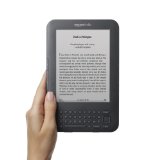UPDATE September 2012:
See this post for the latest round of Amazon Kindles, including the Amazon Kindle Fire HD and the Amazon Kindle Paperwhite.
Original older post below.
—————————-
UPDATE 28 September 2011
New Kindles and a Kindle tablet called the Kindle Fire have been announced. Here is a quick overview of the new Kindle products.
UPDATE 9 October 2010
The Kindle 3 is out, and there are three models to choose from:
- Kindle Wi-Fi Graphite
- Kindle 3G + Wi-Fi Graphite
With the latest generation, the above three Kindles offer higher contrast screens, lighter and thinner designs, better battery life, faster page turns, and better PDF document reading options than the first generation Kindles.
Click any of the above links to get more details, including a comparison chart of all the features and prices.
Information on previous models is below.
NOTE: The Kindle 2
is out now! Here’s my review of the new kindle book reader.
THE COMMENTARY BELOW IS FOR THE ORIGINAL KINDLE.

Amazon has introduced an ebook reader — the Kindle
.
While many people have been longing for a competent ebook reader for some time, to date no one has been able to produce an ebook reader with the right features:
- read files (books, magazines, newspapers, documents, text) in a variety of formats, including open ones, such as .doc, .pdf, .txt, .rft, .html, etc.
- allow the easy addition and deletion of books from the device
- display the books competently
- have an interface suitable for book reading, browsing, searching, and note-taking
-
don’t overwhelm me with fees and crippled file formats
While Amazon seems to have done OK on the display part, and the book reading interface seems to be OK, unfortunately the kindle seems to fail on the other points. The words of Amazon’s CEO Jeff Bezos gives you a hint of why the kindle is not the device we have all been waiting for:
This isn’t a device, it’s a service.
Basically, Amazon is selling you a $400 device that you use to rent digital books from Amazon and then read them on that device. You are not actually buying a digital copy of a book from Amazon. You are renting the book because Amazon encodes the book in a proprietary (DRM) format that does not work with other devices or software. Further, that crippled book can only be read as long as Amazon wants you to be able to read it. From their terms of service:
Your rights under this Agreement will automatically terminate without notice from Amazon if you fail to comply with any term of this Agreement. In case of such termination, you must cease all use of the Software and Amazon may immediately revoke your access to the Service or to Digital Content without notice to you and without refund of any fees. Amazon’s failure to insist upon or enforce your strict compliance with this Agreement will not constitute a waiver of any of its rights.
And, unlike real books or digital files that are not crippled (DRM), you cannot share your rented Amazon book with anyone else:
You may not sell, rent, lease, distribute, broadcast, sublicense or otherwise assign any rights to the Digital Content or any portion of it to any third party, and you may not remove any proprietary notices or labels on the Digital Content. In addition, you may not, and you will not encourage, assist or authorize any other person to, bypass, modify, defeat or circumvent security features that protect the Digital Content.
Other deal-breakers include the fact that, while you can read Amazon-selected files with the kindle, you must pay a few dollars per month to do so – you must subscribe to read a blog that you can read for free using your computer. Also, some files can be transferred to the device via USB, but some must be emailed to the device via Amazon – Amazon “converts” the document into a kindle format (applies DRM) and charges you $.10 per document for the privilege.
If Amazon included a digital copy of each book I buy from Amazon, I think the kindle would work. But as it currently is configured, especially without support for at least .pdf files (a really big deal — I have a lot of .pdf files on my laptop, and I would pay good money for a viable device to read them with) the kindle business model does not make sense to me. I currently do not need an expensive device that basically allows me to read rented books on it, and where I am nickle-and-dimed with monthly fees for the privilege. It seems like a step in the right direction for a useful ebook reader, but Amazon has more work to do. Maybe in version 2.0 they will do better.
Other commentary on the kindle:
dive into mark
-
- have an interface suitable for book reading, browsing, searching, and note-taking
- display the books competently
- allow the easy addition and deletion of books from the device
- read files (books, magazines, newspapers, documents, text) in a variety of formats, including open ones, such as .doc, .pdf, .txt, .rft, .html, etc.
- Kindle 3G + Wi-Fi Graphite
boing-boing gadgets kottke.org wired macworld
<!-- technorati tags start -->
<p style="text-align:right;font-size:10px;">
Technorati Tags: <a href="http://www.technorati.com/tag/book" rel="tag">book</a>, <a href="http://www.technorati.com/tag/review" rel="tag">review</a>, <a href="http://www.technorati.com/tag/technology" rel="tag">technology</a>
</p>
<!-- technorati tags end -->
